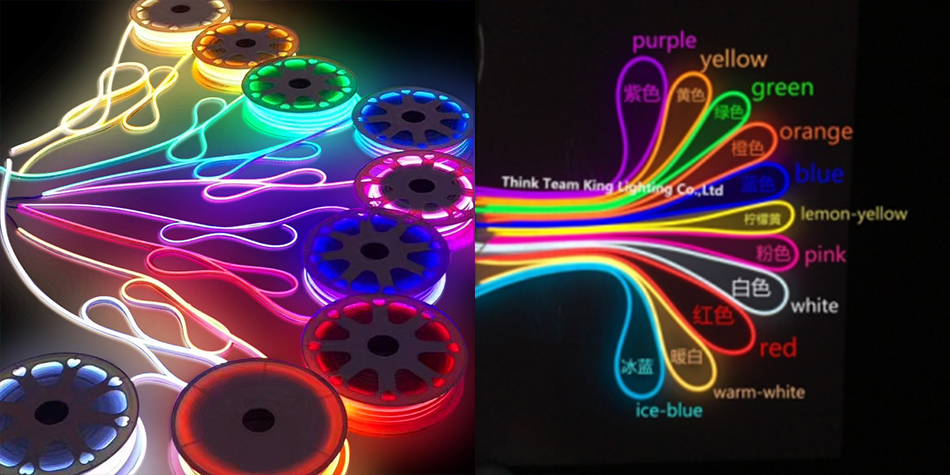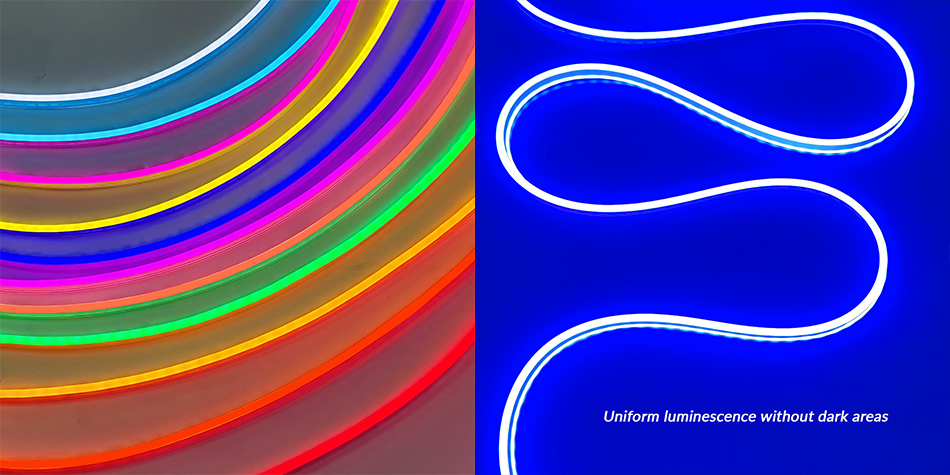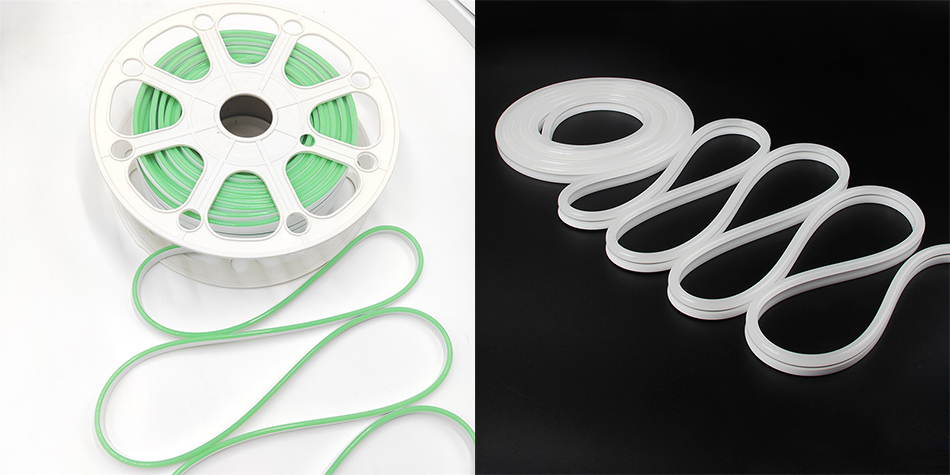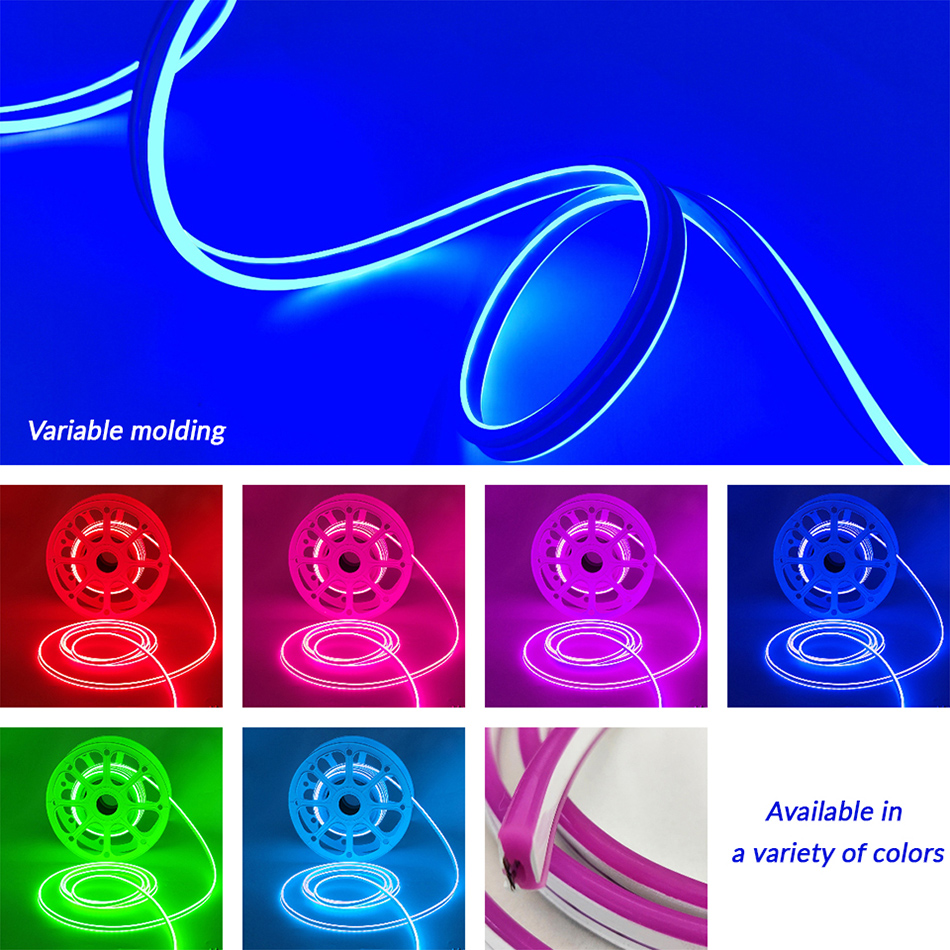Time:2025-07-10
The Paradigm Shift in Neon Strip Installation
In the ever-evolving landscape of lighting technology, cuttable neon strips with solderless connectors have emerged as a game-changing solution for both professional installers and DIY enthusiasts. These innovative systems eliminate the need for traditional soldering— a process that requires technical skill, specialized tools, and time— replacing it with intuitive, tool-free connection methods. By combining precision cuttable intervals with user-friendly solderless connectors, these strips simplify the installation process while maintaining high standards for durability and performance.
This advancement addresses a long-standing challenge in lighting design: how to achieve custom configurations without compromising on ease of use or electrical reliability. Whether for residential accent lighting, commercial signage, or industrial applications, cuttable neon strips with solderless connectors offer a versatile, accessible solution that bridges the gap between creativity and practicality.

Technical Foundations: How Solderless Connectors Transform Installation
Core Features of Solderless Connection Systems
Tool-Free Connectivity Mechanisms
Solderless connectors are designed for quick, secure assembly without soldering:
Press-Fit Connectors: Spring-loaded terminals grip the stripped ends of the neon strip’s PCB, creating a mechanical and electrical connection through pressure alone.
Snap-Lock Adapters: Interlocking plastic housings that align contact points precisely, often with audible clicks to confirm a secure fit.
Magnetic Couplers: Rare-earth magnet-based connectors that auto-align and bond with metal contacts on the strip, ideal for temporary or frequently reconfigured setups.
Precision Cuttable Intervals
Like their soldered counterparts, these strips feature pre-marked cut points at regular intervals (typically every 3–6 inches), aligned with the strip’s circuitry. The key difference lies in the connector interface:
Reinforced Cut Ends: Each cut point includes exposed copper pads or contact strips designed to mate seamlessly with solderless connectors, ensuring low-resistance conductivity.
Error-Prevention Markings: Laser-engraved symbols or color-coded indicators to guide users to valid cut locations, minimizing the risk of damaging the strip’s circuitry.
Low-Voltage Safety & Compatibility
Operating at 12V or 24V DC, these systems prioritize safety and ease of power integration:
Plug-and-Play Power Adapters: Standardized connectors match common power sources (USB, battery packs, wall adapters), eliminating the need for custom wiring.
Polarity Protection: Many connectors include keyed interfaces to prevent incorrect positive/negative alignment, safeguarding against short circuits.

Types of Solderless Connectors for Neon Strips
Press-Fit Blade Connectors
Design: Flat metal blades insert into slots on the neon strip’s PCB, secured by friction or locking tabs.
Advantage: Ultra-compact profile, ideal for tight spaces like under-cabinet lighting or jewelry displays.
Application: Residential DIY projects, where minimal visibility of connectors is preferred.
Snap-Fit Universal Connectors
Design: Two-part plastic housing with internal metal contacts that snap over the stripped end of the strip.
Advantage: Tool-free installation with audible feedback, suitable for both LED neon flex and traditional neon tubes (with adapters).
Application: Commercial signage and retail displays, requiring quick assembly and disassembly for seasonal reconfigurations.
Waterproof Solderless Connectors
Design: IP65/IP67-rated housings with O-ring seals and locking collars to prevent water ingress.
Advantage: Secure connections in outdoor or high-moisture environments without additional sealing.
Application: Poolside lighting, outdoor signage, and bathroom installations.
Right-Angle Solderless Adapters
Design: 90-degree or adjustable-angle connectors to navigate corners and edges without kinking the strip.
Advantage: Maintains seamless light flow around architectural features like cabinet corners or staircase edges.
Application: Architectural interiors and custom furniture lighting.

Advantages Over Traditional Soldered Connections
Accessibility for All Skill Levels
No Technical Expertise Needed: DIY enthusiasts and non-professionals can assemble complex lighting setups using only household tools (scissors, ruler).
Reduced Training Time: Professionals can onboard new team members faster, as solderless systems eliminate the learning curve for soldering techniques.
Time & Cost Efficiency
Faster Installation: Solderless connections reduce setup time by up to 50% compared to soldering, critical for large projects or time-sensitive installations.
Tool Cost Savings: Eliminates the need for soldering irons, flux, and other specialized equipment, lowering upfront investment.
Design Flexibility
Modular Customization: Easily add, remove, or reposition segments without damaging the strip, ideal for iterative design processes.
Seamless Complex Shapes: Right-angle and flexible connectors enable intricate patterns on curved or angular surfaces, previously challenging with soldered joints.
Reliability & Durability
Vibration Resistance: Snap-lock and press-fit mechanisms maintain contact integrity in high-vibration environments like vehicle interiors or industrial machinery.
Corrosion Protection: Gold-plated or nickel-coated contacts resist oxidation, ensuring long-term conductivity in humid or dusty settings.

Diverse Applications of Solderless Cuttable Neon Strips
Residential & DIY Projects
Interior Decor
Cabinet Lighting: Cut strips to fit kitchen cabinet edges using press-fit connectors, creating seamless under-cabinet illumination without visible wiring.
Bedroom Accents: Use snap-fit connectors to attach neon strips to headboards or mirror frames, adjusting lengths for perfect alignment.
Seasonal Decor: Easily disassemble and reuse strips for holiday decorations, such as Halloween-themed window outlines or Christmas tree accents.
Outdoor Living
Patio Furniture Lighting: Waterproof connectors enable weather-resistant strips along deck railings or pergola edges, powered by solar chargers for off-grid use.
Garden Pathways: Cut strips to follow curved walkways, using right-angle connectors at turns for continuous illumination.
Commercial & Retail Design
Storefront Signage
Modular Channel Letters: Assemble custom-sized neon logos using solderless connectors, allowing easy replacement of individual segments without reworking the entire sign.
POP Displays: Quickly reconfigure point-of-purchase displays by swapping out colored strips via snap-lock connectors, adapting to seasonal promotions.
Hospitality Venues
Restaurant Ambiance: Create dynamic lighting in bars by connecting cuttable strips along counter edges with waterproof connectors, changing colors via remote control.
Hotel Accents: Install neon strips along elevator doors or lobby moldings using magnetic connectors for easy maintenance and design updates.
Industrial & Functional Lighting
Workplace Safety
Machine Edge Lighting: Cut strips to length for industrial equipment, using vibration-resistant connectors to highlight safety zones or operational status indicators.
Warehouse Aisles: Install low-voltage strips along rack edges for improved visibility, with quick-release connectors facilitating shelf reconfigurations.
Transportation Interiors
Vehicle Lighting: Customize car interiors with solderless-connected strips along dashboard edges or RV cabinetry, compatible with 12V vehicle power systems.
Aircraft Cabins: Lightweight solderless connectors meet aviation safety standards for easy installation in overhead bins or seat-back displays.

Step-by-Step Installation Guide for Solderless Systems
Phase 1: Project Planning
Measure & Design: Use digital tools or graph paper to map the layout, noting cut points and connector placements (e.g., inside corners for 隐蔽安装).
Material Selection: Choose connectors based on environment (waterproof for outdoor, magnetic for temporary setups) and strip type (LED neon flex vs. glass neon).
Phase 2: Cutting the Strip
Locate Cut Points: Identify manufacturer-marked intervals (e.g., symbols or dashed lines) and mark the desired length with a marker.
Precision Cutting: Use sharp scissors or a utility knife to trim at the marked point, ensuring a straight cut without fraying the PCB or casing.
Phase 3: Connecting Segments
Strip Preparation: Gently peel back the outer casing to expose 5mm of the PCB contacts at the cut end.
Connector Assembly:
For press-fit connectors: Align the metal blades with the PCB pads and press until secure.
For snap-fit connectors: Insert the strip into the housing and close the latch until it clicks.
Power Integration: Connect the main power supply to the first connector, ensuring correct polarity (match "+" and "-" labels).
Phase 4: Mounting & Testing
Secure Placement: Use adhesive backing, clips, or brackets to mount the strip along the target surface, starting from one end to avoid misalignment.
Function Test: Power on the system to check for uniform illumination and secure connections; re-seat any connectors with inconsistent light output.
Phase 5: Finishing Touches
Cable Management: Use zip ties or conduit to hide power cables, ensuring a clean aesthetic.
Weatherproofing (Outdoor): Apply silicone sealant around waterproof connectors for extra protection, especially in high-exposure areas.
Key Considerations When Choosing Solderless Systems
Connector Compatibility
Strip Type Matching: Ensure connectors are designed for your neon strip (LED flex, glass neon, or hybrid models).
Voltage & Current Rating: Check that connectors can handle the strip’s power requirements to avoid overheating.
Environmental Suitability
Indoor vs. Outdoor Use: Select IP-rated connectors for outdoor applications; opt for corrosion-resistant materials (e.g., nickel-plated contacts) for coastal or industrial environments.
Temperature Resistance: Verify the connector’s operating temperature range, especially for installations near heat sources like radiators or machinery.
Certification & Safety
Electrical Standards: Look for CE, UL, or IEC certifications to ensure compliance with safety regulations, particularly for commercial installations.
RoHS Compliance: Choose lead-free, halogen-free connectors for indoor use to meet environmental and health standards.
Supplier Quality & Support
Connector Durability Testing: Reputable suppliers provide cycle-life data (e.g., number of connect-disconnect cycles) for their connectors.
Installation Resources: Prioritize suppliers offering detailed guides, video tutorials, and customer support for troubleshooting.
Addressing Common Installation Challenges
Challenge 1: Loose Connections After Installation
Root Cause: Inadequate insertion of the strip into the connector or vibration loosening the fit.
Solution: Double-check that the strip is fully seated in the connector; for high-vibration areas, use snap-lock or screw-reinforced connectors.
Challenge 2: Inconsistent Light Output Between Segments
Root Cause: Misaligned contacts or oxidation on the PCB pads.
Solution: Clean contacts with isopropyl alcohol before connecting; ensure the connector covers the entire pad area during assembly.
Challenge 3: Difficulty Cutting Straight at Marked Points
Root Cause: Dull cutting tools or rushing the cutting process.
Solution: Use sharp, precision tools and make slow, steady cuts; practice on scrap segments first to build confidence.
Challenge 4: Water Ingress in Outdoor Connectors
Root Cause: Using non-waterproof connectors in wet environments or improper sealant application.
Solution: Always use IP-rated connectors for outdoor use and apply a thin layer of silicone sealant around the connector housing after installation.
Innovations in Solderless Connector Technology
Smart Solderless Systems
Bluetooth-Enabled Connectors: Integrated microcontrollers allow wireless configuration of connected segments, enabling synchronized color changes or dynamic effects via smartphone apps.
Self-Diagnostic Connectors: LED indicators on connectors signal connection status (e.g., green for secure, red for loose), simplifying troubleshooting.
Eco-Friendly Materials
Biodegradable Connector Housings: Emerging models use plant-based plastics that degrade safely at the end of their lifecycle, reducing environmental impact.
Recycled Metal Contacts: Suppliers are increasingly using recycled copper and brass for connector pins, aligning with circular economy goals.
Miniaturized Designs
Micro Solderless Connectors: Ultra-compact models (5mm width) for use in narrow spaces like jewelry boxes or miniature displays, maintaining full conductivity in tiny form factors.
Foldable Connectors: Patented designs that bend with the strip around 180-degree curves, ideal for complex 3D edge lighting.
Automated Assembly Tools
Robotic Connectors: Industrial-grade systems that automatically cut and connect strips to precise lengths, used by manufacturers for large-scale projects like stadium signage.
Conclusion: The Future of Accessible Lighting Design
Cuttable neon strips with solderless connectors represent a landmark advancement in lighting technology, making professional-grade installations accessible to a broader audience. By eliminating the need for soldering, these systems empower DIY enthusiasts, designers, and installers to bring creative visions to life with unprecedented ease, while maintaining high standards for durability and performance.
As the demand for flexible, customizable lighting continues to grow, solderless connector technology will play a pivotal role in shaping the industry. From residential decor to large-scale commercial projects, the ability to cut, connect, and adapt neon strips without technical barriers opens new possibilities for innovation. By prioritizing compatibility, safety, and quality, users can leverage these systems to create stunning, functional lighting solutions that blend seamlessly with any environment—proving that simplicity and sophistication can coexist in modern illumination design.